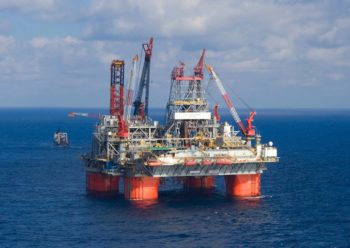
Bloomberg
Tropical Storm Nate has formed off of Nicaragua, threatening to inundate Central America, shut oil and gas rigs in the Gulf of Mexico and damage cotton and citrus crops across the U.S. South.
Nate was about 10 miles (16 kilometers) south of Puerto Cabezas, Nicaragua, with top winds of 40 miles per hour, the U.S. National Hurricane Center said an advisory at 8 a.m. New York time. The storm’s forecast track has it scraping the eastern edge of Mexico’s Yucatan Peninsula before becoming a hurricane south of Louisiana on Sunday. Nate could come ashore anywhere from Louisiana to Florida’s Panhandle.
“Little change in strength is expected today as the center of Nate moves across northeastern Nicaragua and eastern Honduras,” Jack Beven, a senior hurricane specialist at the center in Miami, wrote in the advisory. “Strengthening is likely over the northwestern Caribbean Sea tonight and Friday.”
Fourteen storms have formed across the Atlantic so far this season, killing hundreds of people in the U.S., Mexico and the Caribbean and causing an estimated $300 billion in damage. In August, Hurricane Harvey temporarily shut down about 25 percent of oil and natural gas production in the Gulf and as much as 20 percent of U.S. refining capacity. A few weeks later, Hurricane Irma devastated Florida citrus groves.
There is about 45 percent chance Nate will disrupt energy production in the Gulf, said Matt Rogers, president of the Commodity Weather Group LLC in Bethesda, Maryland. But Rogers said he doesn’t see much chance for any lasting damage because Nate won’t be strong enough.
“The track has shifted to the left and it is going into the eastern production areas,” Rogers said by phone. “The track looks a little ominous, but the intensity is under-performing. That is the reason why we may not get big problems out of this.”
Offshore rigs and platforms in the Gulf of Mexico account for about 17 percent of U.S. crude oil output and 4 percent of gas production. About 45 percent of petroleum refining capacity and 51 percent of gas processing is along the coastline.
Royal Dutch Shell Plc is minimizing staff in the eastern Gulf and taking steps to secure facilities, the company said in a statement. BP Plc is evacuating non-essential staff from its Thunder Horse and Na Kika crude and gas production platforms.
Depending on where Nate ultimately comes ashore, it could mean trouble for Florida citrus farmers left reeling by Hurricane Irma last month, and for cotton growers across the U.S. South.
Orange juice futures rose as much as 2.6 percent Wednesday to $1.594 a pound on ICE Futures U.S. in New York. Florida is the world’s second-largest orange juice producer.
The system “definitely” poses a risk to U.S. cotton-growing areas, particularly western portions of the Southeast including Alabama and Georgia, Donald Keeney, senior meteorologist with MDA Weather Services in Gaithersburg, Maryland, said in a phone interview. Georgia is the second-largest cotton producer after Texas.
Across Nicaragua, Costa Rica, Honduras and Panama, life-threatening landslides are possible as heavy rain falls across the region, the hurricane center said. In Nicaragua as much as 20 inches (51 centimeters) of rain could fall, with isolated pockets of 30 inches possible.
A tropical storm warning is in place along the coast of Honduras and a hurricane watch has been issued for the eastern part of Mexico’s Yucatan Peninsula including Cancun.
Copyright Ships & Ports Ltd. Permission to use quotations from this article is granted subject to appropriate credit given to www.shipsandports.com.ng as the source.
